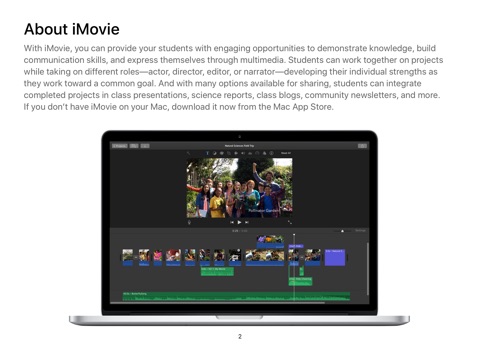Have you ever experienced iMovie crashed a couple of times that you can't complete any of your work? It's not just the obvious physical examples but are the problem, iMovie may crashes on its own when you try to import or edit video clips and that is something you really don’t want to ignore. Since more and more iMovie users complain the annoying issue that iMovie keeps crashing on MacOS, in this page, we'd like to list some reasons that caused iMovie crashing and share the easiest way to fix iMovie crash during importing and editing.
Why iMovie Keeps Crashing on MacOS (High Sierra Included)?
Only Macs that have been purchased new from Apple (or other selected retailers) cones with all of the iLife applications installed as standard, (GarageBand, iMovie etc.). High sierra version 10.13.6. I'm not a requent user of - Answered by a verified Mac Support Specialist We use cookies to give you the best possible experience on our website. I'm running iMovie 10.1.4, on a Macbook, with Sierra Hi, I'm running iMovie 10.1.4, on a Macbook, with Sierra 10.12.6. When I try to share my edited movie, and I click on File Share, nothing happens.
I'm caught in a situation where my computer cannot run Mojave in order for me to use iMovie 10.1.14, but I can also not download an older version of iMovie that works satisfactorily in tandem with my current OS (Sierra 10.12.6) I have been advised to downgrade to Yosemite and continue using iMovie 9.0.9. Any suggestions? The new Mac operating system offers more than a name change. MacOS Sierra version 10.12 moves Apple's desktop OS closer to its mobile counterpart, gaining Siri, Apple Pay, and more.
Actually, iMovie is an excellent video editor well-designed to allow users to import and edit video and photo files from a hard drive for Mac and iOS device(iPhone/Ipad/iPod). It is one of the most useful video editing tool that helps us customize our favorite videos. Since your iMovie keeps crashing on MacOS, here we go to dig deeper why iMovie keeps crashing. It can be summarized in several aspects:
1. iMovie project file got corrupted: Just trash the corrupted files and add the right ones.
2. Errors in iMovie Cache folder: Try to trash cache.mov and cache.plist; creating a new account and login; iMovie will create new error-free pref. and cache files.
3. Preferences are wrong

Mac Os Sierra Imovie
If these solutions mentioned above are not working, you can try the diagnostic procedure below. Restart your computer, and open iMovie while holding down the option and command keys. Then continue to select the delete preferences option in the resulting dialogue box to delete preferences.
The other way is to update to the latest iMovie version: the recent version for iMovie is released to resolve quite a few of issues and the most prominent point is to repair iMovie crashes after MacOS update. Please upgrade your current iMovie version into the latest version to see if it can remove the crash bug.
4. File codec problem
Apple claims that iMovie supports most commonly-used video codecs, including DV, MPEG-2, MPEG-4, H.264, AVCHD and AIC. However, not all files are friendly when working in iMovie. We can easily fixed the first three issues by ourselves, if your iMovie still keeps crashing, the problems must be result from the incompatible codec, which means that the some of the video clips you have imported are not supported by iMovie.
Just convert video files to an iMovie compatiable format. Pavtube iMedia Converter for Mac makes it an easy job, enabling you to encode iMovie project to AIC(Apple Intermediate Codec), which features high performance and quality, being less processor intensive to work with than other editing formats.
The Best Alternative Solution to Fix All iMovie Crashing Problems
Pavtube iMedia Converter for Mac (Review) is not only a tool to solve file codec problem, but also the best iMovie alternative to achieves all basic video editing like what iMovie does, such as trim or cut video to remove the unwanted parts, crop video to get off the black bars around the video frame, add video/image/transparent text watermark to video, change video color effect such as brightness, contrast or saturation or apply some rendering effects, remove/replace audio in video, add external srt/ass/ssa subtitles to video, and more. To some degree, it solves all iMovie crashing problems originated from various reasons.
[How to] Solve iMovie Keeps Crashing Problem with Pavtube iMedia Converter for Mac
Before everything to fix iMovie keeps crashing error, you need free download the iMovie alternative on your Macbook, Macbook Pro/Air, iMac etc. first.
And if you're running on Windows PCs, Pavtube Video Converter Ultimate allows you to edit videos on PCs like what iMovie does on MacOS.
Step 1: Load iMovie project to the programClick 'Add Video' icon to import video files, or 'Load Disc' icon to import Blu-ray or DVD disc to the program.
Step 2: Select output profile formatClick 'Format' bar, from its drop-down option, choose one of iMovie supported file formats such as MPEG-4, DV, HDV, MPEG-2, AVCHD. You can also select to output 'Apple Intermediate Codec(AIC)(*.mov)' to get a high performance and high quality editing workflow.
Step 3: Customize video files
Click the Edit button on the main interface. And here we go to edit (trim, crop, add subtitle/watermark, rotate, subtitle etc.) your videos as you like:
You can also specify video/audio codecs, bitrates, frame rates, etc as you like by clicking Settings button.
Step 4: Begin the conversion process
After all the setting is completed, go back to the main interface, hit right-bottom 'Convert' button to start converting your video files to iMovie supported formats or codec.
When the conversion is finished, click 'Open Output Folder' icon on the main interface to pop out the folder with converted files, then all iMovie crashing problems will fall away.
Before you begin, make sure to back up your iMovie libraries, your media, and the iMovie app.
Try these troubleshooting steps in order
After trying each step below, test iMovie again to see if you've fixed your issue.
Restart your Mac
Reset NVRAM
If you use an external device with iMovie like a camera, reset NVRAM:
- Shut down your Mac.
- Disconnect all external devices other than your keyboard and your mouse.
- Reset NVRAM.
- Open iMovie and attempt to reproduce your issue.
- If iMovie works, reconnect devices one at a time until you can reproduce your issue. Restart your Mac after reconnecting a device if the device requires it.
- If iMovie still doesn't work, you might need to update your device's firmware or have the device serviced.

Update macOS and iMovie
Choose Apple menu > App Store, then click Updates. If an iMovie update is available, click Update to download and install it.
Check camera and media format compatibility
Make sure you're using a camera and media format that works with iMovie. If you can't find your camera listed or need further assistance, contact the manufacturer of the device for support.
If you're using a third-party video interface with your Mac, check with the manufacturer for firmware or other software updates for your device.
Test with a new library and project
You can create a new library and test project to check if the issue is with your library, project, or iMovie app. First, create a new library:
- Quit iMovie.
- While you press and hold the Option key, click the iMovie app in the Dock or double-click the iMovie app in the Applications folder.
- In the Open Library window, click New to create a new library.
- Name the test library 'Test iMovie Library,' then save it to the Desktop.
Next, create the test project using a built-in trailer template, then export it as a QuickTime video file:
- In iMovie, click Projects to return to the Projects view.
- Choose File > New Trailer, click the Action trailer template, then click Create.
- Choose File > Share > File, click Next, name the file 'Finish Line,' then save the video file to the Desktop.
Next, import the QuickTime video file into a new project in the new library:
- Click projects to return to the Projects view. In the window, click OK.
- Choose File > New Movie.
- Choose File > Import Media, then click Desktop in the Import window sidebar. Select the 'Finish Line.mov' file in the list, then click the Import Selected button.
- Select the clip in the browser, then press the E key to add the clip to the timeline.
- Try to recreate the issue you were having. For example, if iMovie quit when adding a transition, try to add a transition to the timeline.
If the new library and project work as expected, you've isolated the cause of your issue to the original library or project. Try to restore a previous version of the original library from a Time Machine or other backup.
Test iMovie with a new user account
Mac Os Sierra Imovie
Create another user account on your Mac, then test iMovie with the new user account.
Reset iMovie
Reset iMovie to default settings. Libraries won't be affected.
Reinstall iMovie
Delete iMovie, then redownload and reinstall it. Libraries won't be affected.